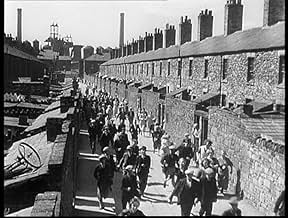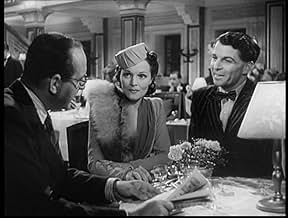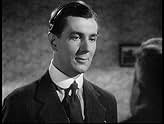अपनी भाषा में प्लॉट जोड़ेंIn a small coal-mining village, Bob Fenwick leads a strike over safety standards at the local colliery. Meanwhile, his son David goes off to university with the hope one day to return to hel... सभी पढ़ेंIn a small coal-mining village, Bob Fenwick leads a strike over safety standards at the local colliery. Meanwhile, his son David goes off to university with the hope one day to return to help the miners with their working conditions.In a small coal-mining village, Bob Fenwick leads a strike over safety standards at the local colliery. Meanwhile, his son David goes off to university with the hope one day to return to help the miners with their working conditions.
- पुरस्कार
- कुल 1 जीत
- Slogger Gowlan
- (as George Carnay)
फ़ीचर्ड समीक्षाएं
The dialogues sound kind of flat or monotonous, but the story is absolutely entertaining enough and the cinematography by Mutz Greenbaum (Thunder Rock) is really fine. He especially knows his way with contrast and composition apparently. Carol Reed (Odd Man Out, Fallen Idol, Third Man) gently develops the story and the points he (and writer Alec Coppel, who also wrote Vertigo and Obsession) wants to make. The movie as a whole is a quite moralistic and a bit too sincere, but again the directing and the cinematography more than make up. At last but not least, Michael Redgrave (Thunder Rock, Mr. Arkadin, the Innocents) puts forward a great deal of realism, enforcing A. J. Cronin's points. A point is that different social classes should have more respect for each other because they are complements, not substitutes. Another point is that it is probably a personal story (Cronin's ?). 8/10
This film was a breakout success for Carol Reed who up to that time had been limited to what we call B picture features and what over the other side of the pond call quota quickies. It was produced by an independent studio called Grafton films and released here by the short lived Grand National Studios. Reed was contracted to Gainsborough Pictures and he was able to get fellow contractees Michael Redgrave, Margaret Lockwood, and Emlyn Williams for this production.
I don't think that Michael Redgrave was ever more idealistic on the screen than he was in The Stars Look Down. He plays a working class stiff who earns a scholarship to the university and he intends to use that education for the benefit of the miner class from where he comes. But this idealist is very human and he makes the wrong choice in a life partner in the form of pretty, but shallow Margaret Lockwood who sees him as a meal ticket to get ahead herself.
The guy who Lockwood was going with is Emlyn Williams who would be called a cad and a bounder over there. He's also a miner's kid, but his method of escape isn't exactly condoned in polite society, he becomes a bookmaker. Eventually he joins with management. One great thing about The Stars Look Down is we see where all these three characters came from and the values imparted to them.
Redgrave has two marvelous scenes that really stand out. The first is when he's in class and making an eloquent case in class for the government ownership of the coal mines. The second is before the Board of Trade arguing that the mine his father and others in his district is not safe because where they want to mine is holding back the sea itself. His own personal problems prevent the Board from listening to him. In both Redgrave personifies youthful idealism and impatience. In the end it's shown he has good reason to be impatient.
The film was shot on location at an actual colliery in Cumberland and the scenes depicting the mine disaster which is the climax of the film are frighteningly real and hold up well today. The film stands comparison to How Green Was My Valley which was a film on the same subject, but done in the poetical style of John Ford and done over here.
The Stars Look Down will still move the viewers and the problems of industrial safety are just as real today as they were when The Stars Look Down came out.
Michael Redgrave stars as a young idealist, determined to get an education so that he can improve conditions in the mining town where he lives. Redgrave's performance quietly brings out a lot about his character, as he learns about reality while fighting for the truth. Emlyn Williams is also effective as Redgrave's boyhood friend, who takes an entirely different, amoral approach to the same situation. Margaret Lockwood, well-cast as the rather vain young woman who captivates both of them, adds an important dimension. Several of the supporting cast members also do a good job in limited screen time.
The highlight is the extended rescue sequence in the second half, and it is very effectively done. But one of the reasons that it works so well is that it was prepared by such a solid foundation, establishing the characters and issues carefully so that, when the crisis hits, everything takes on more meaning.
Many of the topics touched upon by the movie are still of significance in themselves, but even beyond that, it creates a good deal of worthwhile drama about society and human nature in general.
It was of particular interest because the novelist, A.J. Cronin actually set the novel near my home town of Ashington in the North East of England, and got it pretty well right as he'd worked as a medic in the area for some years. Interestingly enough, I noticed that many US critics refer to it as being set in a "Welsh" mining village. This may well be because they recognised Emlyn Williams's accent as Welsh and the rest were a pretty mixed bunch - I spotted only one genuine North-East accent! Like all "Socialist Realism" the melodrama was overplayed - nonetheless, there was some truth and accuracy in there and it was fascinating to see how the movie treats coal miners - rightly, in my opinion - as heroic figures.
An unjustly neglected classic.
क्या आपको पता है
- ट्रिवियाSir Carol Reed disowned this movie, calling it "a gloomy little piece". He expected it to be a box-office disaster and was highly surprised when wartime audiences warmed enthusiastically to it.
- भाव
[first lines]
Richard Barras: Well, Fenwick, will the men work tomorrow?
Robert Fenwick: Not if its to be in Scupper Flats, Mr. Barras.
[indicating a well-dressed union official]
Richard Barras: Even against your union?
Robert Fenwick: The union isn't being asked to work in Scupper Flats. On the other side of that coal seam is a million tons of flood water ready to rush right down on top of us.
Richard Barras: You don't think I'd take a chance in floodin' me own mine, do you, Fenwick?
Robert Fenwick: Well, show us the plans of them old workings, then!
- इसके अलावा अन्य वर्जनThe U.S. release included additional narration spoken by an uncredited Lionel Barrymore.
- कनेक्शनFeatured in The Love Goddesses (1965)
टॉप पसंद
- How long is The Stars Look Down?Alexa द्वारा संचालित
विवरण
- रिलीज़ की तारीख़
- कंट्री ऑफ़ ओरिजिन
- भाषा
- इस रूप में भी जाना जाता है
- Zvezde gledaju sa neba
- फ़िल्माने की जगहें
- Cumbria, इंग्लैंड, यूनाइटेड किंगडम(Exterior)
- उत्पादन कंपनी
- IMDbPro पर और कंपनी क्रेडिट देखें
- चलने की अवधि
- 1 घं 50 मि(110 min)
- रंग
- पक्ष अनुपात
- 1.37 : 1
























